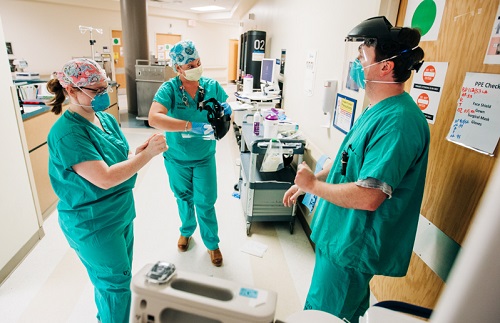
September 20, 2021 – About a year ago in mid-September 2020, the most severe Covid wave in the United States formed. Yes, the Fall/Winter 2020 surge was worse than the recent Delta wave, surpassing Delta’s duration, infections, peak daily infection rate, hospital days, and deaths. When the Fall/Winter wave crested four months later, the average daily case rate spiked seven-fold.
Should we anticipate a similar seasonal pattern this Fall? If so, we are already starting at a daily infection rate four times higher than it was on September 13 of last year. A seven-fold spike in cases like last Fall’s experience would be devastating. Fortunately, several factors are working to our advantage going into this Fall.
First, the virulent Delta variant is showing signs of losing steam. Reported case rates have declined 11% in the past two weeks. Daily cases are averaging lower than any time in a month. Estimated infections (which include undetected and asymptomatic cases) plunged 30% in the past three weeks (Institute for Health Metrics and Evaluation (IHME)).
Notably, the recent Delta surge punished southern states more so than states in the Northeast and Midwest. This distinction closely mirrored differences in vaccination rates – states with low vaccinations tended to experience markedly higher infection rates.
On a related note, the Delta variant’s strength has thus far kept newer variants from gaining a foothold here.
Second, we enjoy reasonably strong protection from each of the three vaccines approved for use in the United States. Breakthrough infections among vaccinated persons continue to be relatively few, are short-lived when they occur, and rarely result in hospitalizations or death. Reportedly, most severe breakthrough cases affect the elderly and others with underlying health issues.
However, there are holes in our vaccination effort that expose us to the risk of another surge: As mentioned in the previous paragraph, breakthrough infections are a risk to people with health issues. Over time, the waning efficacy of vaccines complicates this risk, as the elderly and high-risk populations were vaccinated seven to eight months ago.
Last week, the FDA advisory recommendation to offer booster shots to this group was a critical step toward keeping this risk in check.
The second “hole” in our vaccination effort is the slow acceptance among non-seniors and children 12-to-17-years old and the lack of vaccine approval for children under 12. This hole heightens the risk of a renewed surge, particularly as students return to school and cooler temperatures bring us indoors.
Fortunately, there are encouraging developments on this front. Teenagers have been getting vaccinated at a faster rate recently. Two million more teens are now vaccinated than just a month ago. For the first time, there are more teens fully vaccinated than unvaccinated.
Further, we may be moving closer to at least emergency use approval (EUA) for vaccines for children under 12. his morning, Pfizer trumpeted preliminary results from its clinical trials that show both strong efficacy and minimal safety issues. Several reports suggest that the FDA could consider EUA for vaccinating children under 12 sometime in mid-to-late October.
IHME’s latest Covid projections (published late last week) provide a somewhat mixed view of what to expect in the United States this Fall. The good news: IHME does not anticipate a re-run of last Fall’s seven-fold spike in new infections. However, its model envisions an uptick in infections beginning in late October and extending through the end of the year. A closer examination of this forecast reveals an expectation of rising cases in colder states like Michigan, New Jersey, New York, and Pennsylvania. Cases are projected to decline through the end of the year in warmer states like Florida, Georgia, and Texas.
In all, IHME envisions infections will continue falling then, then return by Christmas to the level we are currently experiencing.
Contributing writer:
Mark A. Van Sumeren, strategic advisor, Medical Devices & Integrated Delivery Networks
Health Industry Advisor LLC, provides a regular report on COVID-19 numbers for the health care industry.
For more information, or to sign up for the report, contact Mark at Mark.VanSumeren@HealthIndustryAdvisor.com; or visit www.HealthIndustryAdvisor.com.
